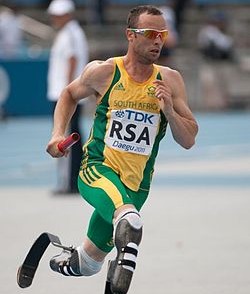Was “Roid Rage” a Factor in Oscar Pistorius’ Shooting Of Reeva Steenkamp

It’s such a shocking reversal of fortune.
Just last summer, Oscar Pistorius, soared to fame at the London Olympic and Paralympic games. He was the first double leg amputee to compete in the Olympics. The 26-year-old South African ran sprints with the use of cutting-edge prostheses, which lead to his nickname as “The Blade Runner.”
This week, we’ve seen Pistorius taken away in handcuffs, accused of fatally shooting his girlfriend, model and reality show contestant Reeva Steenkamp. Pistorius is set to appear for a bail application hearing tomorrow.
Official details remain scarce, however UK’s The Sun is reporting that banned steroid drugs were found in Oscar Pistorius’s house. Also found was a blood-stained cricket bat, and there is evidence of gun shots through the bathroom door.
What are Anabolic steroids?
Anabolic steroids (AS) are artificial versions of testosterone, a hormone that all individuals have naturally in their bodies. Anabolic steroids, the most frequently abused of all steroids, are taken orally or injected to:
- enhance athletic performance
- increase stamina
- improve physical appearance.
Anabolic means “muscle-building.” Steroids are often taken in cycles of weeks or months rather than continuously.
These drugs were originally developed in the late 1930s to treat diseases where the body is deficient in normal concentrations of sex hormones but were also found to increase the growth of skeletal muscles in laboratory animals. This led to the abuse of these substances, first by weightlifters and body builders but later by athletes in other sports as well.
What are the effects of steroids on the brain?
When a person takes steroids, the drugs are distributed to many regions of the brain, including the hypothalamus.
Testosterone is naturally produced in the hypothalamus, which controls appetite, blood pressure, moods, and reproductive ability. Steroids alter the normal functioning of the hypothalamus, resulting in changes in the amount of testosterone that is sent throughout the body. Because testosterone plays a role in many body functions, this can result in the many effects seen with steroid abuse.
Steroids can also disrupt the functioning of neurons in the limbic system, the part of the brain responsible for emotional regulation. This disruption can lead to:
- aggressive behavior
- mood swings
- violent behavior
- impairment of judgment
- psychotic symptoms like personality changes or paranoia
How much steroid abuse contributes to violence and behavioral disorders is unknown. Case reports and small studies indicate that anabolic steroids, when used in high doses, increase irritability and aggression. Some steroid abusers report that they have committed aggressive acts, such as physical fighting or armed robbery, theft, vandalism, or burglary. Abusers report that they are more likely to commit aggressive acts when they are on steroids than when they are drug free.
Anabolic steroids can also affect mental health. Although many users report feeling good about themselves while on anabolic steroids, extreme mood swings can also occur, including manic-like symptoms that could lead to violence. Researchers have also observed that users may suffer from paranoid jealousy, extreme irritability, delusions, and impaired judgment stemming from feelings of invincibility.
The term “roid rage” is really a made-up term to describe some of the aggressive behavior seen in some AS abusers. For example, Pro wrestler Chris Benoit may have had “roid rage” when he killed his wife and son before hanging himself.



























0 comments